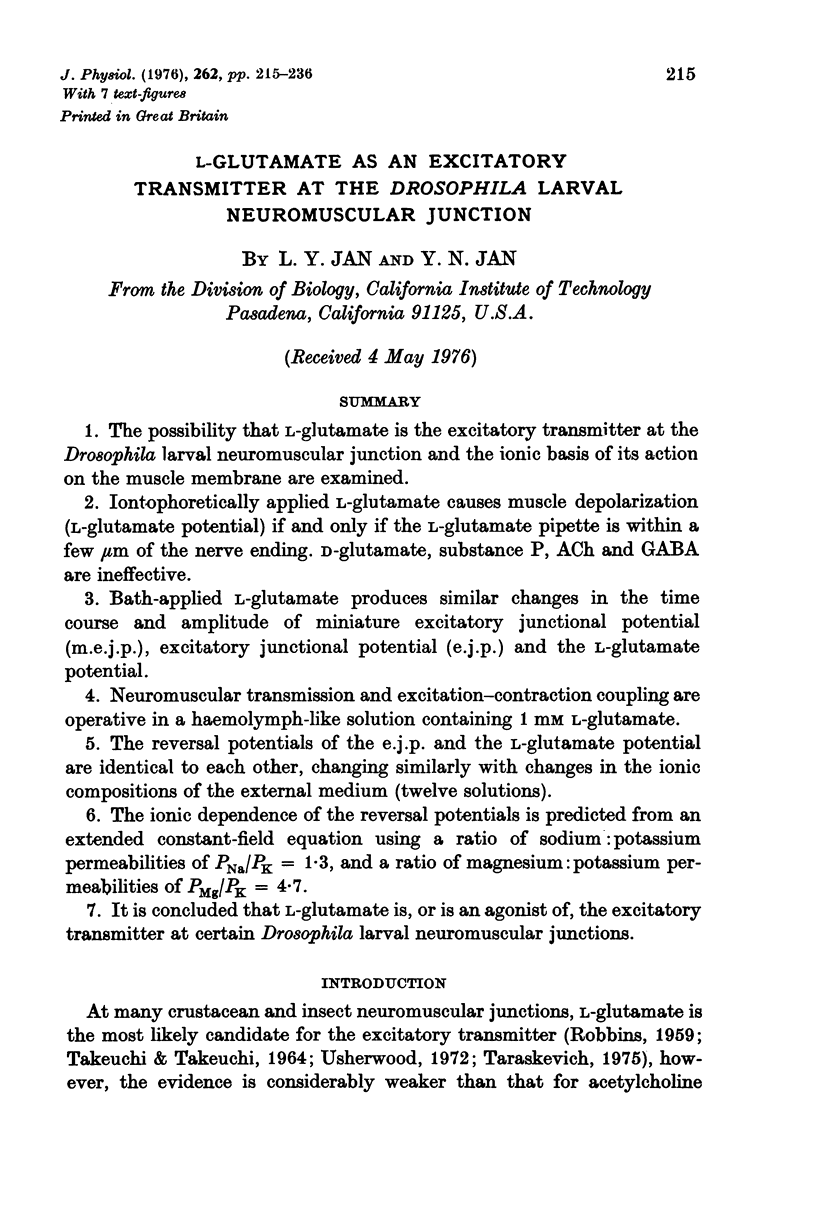Abstract
The possibility that L-glutamate is the excitatory transmitter at the Drosophila larval neuromuscular junction and the ionic basis of its action on the muscle membrane are examined. 2. Iontophoretically applied L-glutamate causes muscle depolarization (L-glutamate potential) if and only if the L-glutamate pipette is within a few mum of the nerve ending. D-glutamate, substance P, ACh and GABA are ineffective. 3. Bath-applied L-glutamate produces similar changes in the time course and amplitude of miniature excitatory junctional potential (m.e.j.p.), excitatory junctional potential (e.j.p.) and the L-glutamate potential. 4. Neuromuscular transmission and excitation-contraction coupling are operative in a haemolymph-like solution containing 1 mM L-glutamate. 5. The reversal potentials of the e.j.p. and the L-glutamate potential are identical to each other, changing similarly with changes in the ionic compositions of the external medium (twelve solutions). 6. The ionic dependence of the reversal potentials is predicted from an extended constant-field equation using a ratio of sodium:potassium permeabilities of PNa/PK=1-3, and a ratio of magnesium:potassium permeabilities of PMg/PK=4-7. 7. It is concluded that L-glutamate is, or is an agonist of, the excitatory transmitter at certain Drosophila larval neuromuscular junctions.
Full text
PDF





















Selected References
These references are in PubMed. This may not be the complete list of references from this article.
- Anwyl R., Usherwood P. N. Proceedings: The ionic permeability changes caused by the excitatory transmitter at the insect neuromuscular junction. J Physiol. 1975 Jul;249(1):24P–25P. [PubMed] [Google Scholar]
- Anwyl R., Usherwood P. N. Voltage clamp studies of glutamate synapse. Nature. 1974 Dec 13;252(5484):591–593. doi: 10.1038/252591a0. [DOI] [PubMed] [Google Scholar]
- Bregestovski P. D., Chailachjan L. M., Dunin-Barkovski V. L., Potapova T. W., Veprintsev B. N. Effect of temperature on the equilibrium endplate potential. Nature. 1972 Apr 28;236(5348):453–454. doi: 10.1038/236453a0. [DOI] [PubMed] [Google Scholar]
- Chen P. S., Kubli E., Hanimann F. Auftrennung der freien Ninhydrin-positiven Stoffe in Phormia und Drosophila mittels zwei-dimensionaler Hochspannungselektrophorese. Rev Suisse Zool. 1968 Sep;75(3):509–523. [PubMed] [Google Scholar]
- Cull-Candy S. G. Two types of extrajunctional L-glutamate receptors in locust muscle fibres. J Physiol. 1976 Feb;255(2):449–464. doi: 10.1113/jphysiol.1976.sp011289. [DOI] [PMC free article] [PubMed] [Google Scholar]
- DEL CASTILLO J., KATZ B. On the localization of acetylcholine receptors. J Physiol. 1955 Apr 28;128(1):157–181. doi: 10.1113/jphysiol.1955.sp005297. [DOI] [PMC free article] [PubMed] [Google Scholar]
- Dudel J. Nonlinear voltage dependence of excitatory synaptic current in crayfish muscle. Pflugers Arch. 1974;352(3):227–241. doi: 10.1007/BF00590488. [DOI] [PubMed] [Google Scholar]
- Dudel J. Potentiation and desensitization after glutamate induced postsynaptic currents at the crayfish neuromuscular junction. Pflugers Arch. 1975;356(4):317–327. doi: 10.1007/BF00580005. [DOI] [PubMed] [Google Scholar]
- Faeder I. R., Matthews J. A., Salpeter M. M. (3H)glutamate uptake at insect neuromuscular junctions: effect of chlorpromazine. Brain Res. 1974 Nov 8;80(1):53–70. doi: 10.1016/0006-8993(74)90723-9. [DOI] [PubMed] [Google Scholar]
- Faeder I. R., Salpeter M. M. Glutamate uptake by a stimulated insect nerve muscle preparation. J Cell Biol. 1970 Aug;46(2):300–307. doi: 10.1083/jcb.46.2.300. [DOI] [PMC free article] [PubMed] [Google Scholar]
- Finkelstein A., Mauro A. Equivalent Circuits as Related to Ionic Systems. Biophys J. 1963 May;3(3):215–237. doi: 10.1016/s0006-3495(63)86817-4. [DOI] [PMC free article] [PubMed] [Google Scholar]
- Gerschenfeld H. M. Chemical transmission in invertebrate central nervous systems and neuromuscular junctions. Physiol Rev. 1973 Jan;53(1):1–119. doi: 10.1152/physrev.1973.53.1.1. [DOI] [PubMed] [Google Scholar]
- Ginsborg B. L. Electrical changes in the membrane in junctional transmission. Biochim Biophys Acta. 1973 Nov 28;300(3):289–317. doi: 10.1016/0304-4157(73)90007-5. [DOI] [PubMed] [Google Scholar]
- HODGKIN A. L., KATZ B. The effect of sodium ions on the electrical activity of giant axon of the squid. J Physiol. 1949 Mar 1;108(1):37–77. doi: 10.1113/jphysiol.1949.sp004310. [DOI] [PMC free article] [PubMed] [Google Scholar]
- Ito Y., Kuriyama H., Tashiro N. Miniature excitatory junction potentials in the somatic muscle of the earthworm, Pheretima communissima, in sodium free solution. J Exp Biol. 1969 Aug;51(1):107–118. doi: 10.1242/jeb.51.1.107. [DOI] [PubMed] [Google Scholar]
- KRAVITZ E. A., KUFFLER S. W., POTTER D. D. GAMMA-AMINOBUTYRIC ACID AND OTHER BLOCKING COMPOUNDS IN CRUSTACEA. III. THEIR RELATIVE CONCENTRATIONS IN SEPARATED MOTOR AND INHIBITORY AXONS. J Neurophysiol. 1963 Sep;26:739–751. doi: 10.1152/jn.1963.26.5.739. [DOI] [PubMed] [Google Scholar]
- Kehoe J. Ionic mechanisms of a two-component cholinergic inhibition in Aplysia neurones. J Physiol. 1972 Aug;225(1):85–114. doi: 10.1113/jphysiol.1972.sp009930. [DOI] [PMC free article] [PubMed] [Google Scholar]
- Kuffler S. W., Yoshikami D. The distribution of acetylcholine sensitivity at the post-synaptic membrane of vertebrate skeletal twitch muscles: iontophoretic mapping in the micron range. J Physiol. 1975 Jan;244(3):703–730. doi: 10.1113/jphysiol.1975.sp010821. [DOI] [PMC free article] [PubMed] [Google Scholar]
- Lowagie C., Gerschenfeld H. M. Glutamate antagonists at a crayfish neuromuscular junction. Nature. 1974 Apr 5;248(448):533–535. doi: 10.1038/248533a0. [DOI] [PubMed] [Google Scholar]
- Onodera K., Takeuchi A. Ionic mechanism of the excitatory synaptic membrane of the crayfish neuromuscular junction. J Physiol. 1975 Oct;252(1):295–318. doi: 10.1113/jphysiol.1975.sp011145. [DOI] [PMC free article] [PubMed] [Google Scholar]
- Otsuka M., Konishi S. Substance P and excitatory transmitter of primary sensory neurons. Cold Spring Harb Symp Quant Biol. 1976;40:135–143. doi: 10.1101/sqb.1976.040.01.015. [DOI] [PubMed] [Google Scholar]
- ROBBINS J. The excitation and inhibition of crustacean muscle by amino acids. J Physiol. 1959 Oct;148:39–50. doi: 10.1113/jphysiol.1959.sp006272. [DOI] [PMC free article] [PubMed] [Google Scholar]
- TAKEUCHI A., TAKEUCHI N. THE EFFECT ON CRAYFISH MUSCLE OF IONTOPHORETICALLY APPLIED GLUTAMATE. J Physiol. 1964 Mar;170:296–317. doi: 10.1113/jphysiol.1964.sp007332. [DOI] [PMC free article] [PubMed] [Google Scholar]
- USHERWOOD P. N., GRUNDFEST H. PERIPHERAL INHIBITION IN SKELETAL MUSCLE OF INSECTS. J Neurophysiol. 1965 May;28:497–518. doi: 10.1152/jn.1965.28.3.497. [DOI] [PubMed] [Google Scholar]


